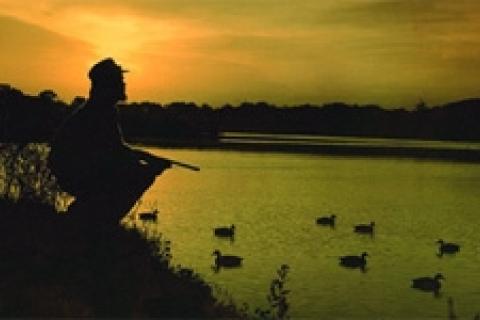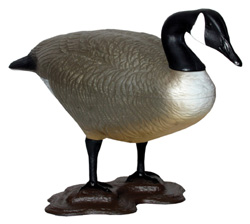
In the half-light of a winter morning, we set the duck decoys.
 "This one goes here," my hunting companion says, a thoughtful decision born of careful observation and past experience. Line, anchor and plastic duck sing through the chill air, landing with a hollow splash. The decoy bobs upright, then swings into place. It dances in the pre-dawn breeze, suddenly alive.
"This one goes here," my hunting companion says, a thoughtful decision born of careful observation and past experience. Line, anchor and plastic duck sing through the chill air, landing with a hollow splash. The decoy bobs upright, then swings into place. It dances in the pre-dawn breeze, suddenly alive.
![]() TIP: Confidence decoys make your spread visible from a greater distance - LINK
TIP: Confidence decoys make your spread visible from a greater distance - LINK
Slowly the picture takes shape, creating an illusion of nature and life. The placid water gains dimension and depth as decoy after decoy is placed, each carefully gauged to complement the whole.
"See them?" my friend asks a few minutes later, nodding upstream. Heading our way, a flock of fast-moving ducks turns in the vastness above the big river.
The birds continue on, however, never looking toward what seems to me a perfect decoy set-up. During the next two hours, more than a dozen flocks pass us. My friend's excellent calling does nothing to draw their attention.
A week later, we are back. "Ducks are here" says my friend, "We saw hundreds last week. We've just got to figure out how to get them to decoy, and I think I've got the answer."
When the last full-body mallard decoy is set, he goes to the boat and brings back three Canada goose decoys, and to my surprise, a half dozen crow decoys as well. The geese dekes are placed to one side of the mallard spread, in shallow water at the edge of a sandbar. He places the crow dekes on the other side of the spread. Some are set in bushes, some on the ground.
"These are confidence decoys," he replies. "I've never used them, but they're supposed to make your spread look more realistic. When flying ducks see wary birds like crows and Canada geese nearby, they're more likely to believe the duck decoys are real. Ducks know that geese and crows are real skittish, and they figure those birds wouldn't hang around if there was any threat. It makes the ducks feel more secure, so they're more likely to drop in for a visit."
If you've never used confidence decoys or perhaps thinking you should, study the following information and try them sometime. See if you think they make a difference. Chances are good you will.
8 Types of Confidence Waterfowl Decoys
Confidence decoys have the same purpose: to create an embellished sense of realism that gives ducks confidence in their decision to land in your decoy spread. Each confidence decoy is an added detail that helps relay the message, "It's safe here. Come on down." In the strictest sense, a confidence decoy is an imitation of a species you probably don't intend to shoot but one that might normally be found among a contented flock of waterfowl. These are normally waterbirds or wading birds. The confidence decoys most commonly used represent geese, herons, coots and sea gulls. Where swans are common, swan decoys often are employed in this manner. Other species occasionally used include sandhill cranes and egrets.
 |
| Canada geese often feed at the edges of duck flocks in pairs or groups, making Canada goose excellent confidence decoys and one of the most popular among waterfowlers. |
1. Geese
Geese are probably the most commonly used confidence decoys. Waterfowlers nationwide use them to enhance their duck decoy spreads.
Some hunters may use white-fronted or snow goose representations, but these aren't often employed as these species tend to form their own large flocks and seldom mingle as singles or small groups near a flock of ducks. Canada geese, on the other hand, often feed at the edges of duck flocks in pairs or groups. Consequently, Canada goose decoys make good confidence decoys.
These are wary birds, so their presence in a rig indicates all is okay. And more importantly perhaps, their large size allows them to be seen from a greater distance, adding visibility to the spread. Most savvy waterfowlers consider it best to place them in pairs here and there on the outside edge of the duck decoys (on shore or in the water), typically on the upwind side. Standing, floating and silhouette models are available.
 |
| Coots often mix with flocks of puddle ducks, eating vegetation and bugs stirred up by dabblers such as pintails, wigeons, gadwalls and mallards. |
2. Coots
Coot decoys like like those by Hard Core Decoys are also good confidence decoys. They were commonly added to the decoy spreads of nineteenth-century hunters, and because they're readily available today, they still are used by enterprising waterfowlers.
Coots often mix with flocks of puddle ducks, eating vegetation and bugs stirred up by dabblers such as pintails, wigeons, gadwalls and mallards. To a lesser extent, they also attend flocks of redheads, canvasbacks, ring-necked ducks and other divers. Whenever coots are in the area you're hunting, you might want to consider setting at least a dozen coot decoys to the side of your duck decoys.
3, 4, & 5 are Herons, Egrets and Cranes
Great blue herons are among the wariest North American birds. Consequently, confidence decoys representing this species are among those most used by waterfowlers. By placing one or two of these decoys about 50 to 100 yards away from your waterfowl decoys, you can create an appearance of safety for passing duck flights.
 |
| Great blue herons (bottom) are among the wariest North American birds. |
Some hunters prefer egret decoys, which are white, saying they are more visible to ducks. And in states where sandhill cranes are common, hunters often add crane decoys such as the Flambeau Sandhill Crane Decoy to their spreads.
6. Sea Gulls
Sea gull decoys may be the oldest type of confidence decoy still in use. Hunters in coastal areas of the East and North used them more than a century ago. Usually one or two gulls were positioned on the edge of the set to give it a natural look, but some hunters placed them right on top of their sinkboxes or lined them up on top of blinds.
Sea gull confidence decoys still remain popular with some coastal hunters hoping to sneak under the radar of wary divers and sea ducks. Hunters on inland water bodies use them only rarely, but a few sea gulls added to a spread on one of the many lakes or rivers frequented by gulls would probably prove useful. Standing and floating models are available.
7. Swans
 |
| Swan decoys are large, thus making your spread more visible to high-flying or distant ducks. |
Swans have become increasingly abundant in several states in recent decades, and some hunters have begun adding swan decoys to their spreads with reported success. Because manufactured swan decoys tend to be relatively expensive, these hunters often paint Canada goose decoys white to represent swans. But regular swan decoys are available for hunters who don't want to go to that trouble.
Swan decoys like goose decoys are large, thus making your spread more visible to high-flying or distant ducks. One or two placed near the edge of your regular spread may draw ducks that would otherwise pass you by. If you hope to bag some geese as well, however, hunters in-the-know say to dispense with the swan decoys. Geese apparently won't land when swans are nearby.
8. Crows
 |
| In states where sandhill cranes are common, hunters often add crane decoys to their spreads. |
It's difficult to trace the evolution of the crow decoy as a confidence decoy for ducks. But at some point in time, an enterprising waterfowler noticed crows feeding near his duck decoys and decided to add a few crow decoys to the mix. They worked and word spread that having a few wary-crow imitations in the
bushes and along the shore could help make a set-up appear more safe and realistic. I've met several hunters who swear by their effectiveness. And because crow decoys are relatively inexpensive, they're often the confidence decoy of choice for frugal hunters.
Do Confidence Decoys Work?
In summary, I have to tell you I have no direct evidence to prove that confidence decoys will increase the number of ducks that drop into your decoy spread. There are no scientific studies to prove or disprove their effectiveness.
Confidence decoys have been used for more than a century, however, a fact that convinces me of their positive attributes, and several times I've experienced better hunting with confidence decoys in the spread than without. At the very least, they give me more confidence in my ability to create a decoy spread that looks totally real to ducks. And that's reason enough for me to keep using them. Try them and decide for yourself. I think you'll be glad you did.
- 16818 views

